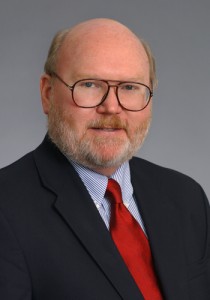IEEE Joint AESS and JCAM Seminar
Wednesday, October 24th, 2012
Dr. William D. Blair, Georgia Tech Research Institute
“Design of Nearly Constant Velocity Track Filters for Tracking Maneuvering Targets”
11:30am – 1:00pm
Location: Dynetics – Solutions Complex Main Conference Room
1004 Explorer Boulevard (in Research Park)
See map at: http://www.dynetics.com/pdf/HuntsvilleAlabama.pdf
Lunch will be provided to Attendees
RSVP to Charlene Neely (by COB on 10/22/2012) at: Charlene.Neely@dynetics.com
(Please send US Citizenship information with RSVP – YES or NO)
Bio: William Dale Blair, Ph.D., is a principal research engineer with GTRI and currently serves as the Technical Director for the C2BMC Knowledge Center of the Missile Defense Agency (MDA). Since joining GTRI in 1997, Dr. Blair has led a multi-organizational team in the development of multiplatform-multisensor-multitarget benchmarks to both air defense and ballistic missile defense. His projects at GTRI focus mostly the modeling and simulation and algorithm assessment associated with the sensor netting for the battle management, command, and control for the ballistic missile defense system. Dr. Blair’s research is reported in over two hundred articles which include 38 refereed journal articles. Dr. Blair served as the Editor for Radar Systems for IEEE Transactions on Aerospace and Electronic Systems (T-AES) 1996-99 and Editor-In-Chief (EIC) for IEEE T-AES from 1999-2005. Dr. Blair is a Fellow of the IEEE and recipient of the 2001 IEEE Nathanson Award for Outstanding Young Radar Engineer. He originated and coordinates four short courses, Target Tracking in Sensor Systems, Target Tracking Concepts, Advanced Target Tracking for Air Defense and Advanced Target Tracking for Ballistic Missile Defense, for the Professional Education Department of the GIT. Dr. Blair is coeditor and coauthor of the book, Multitarget-Multisensor Tracking: Advances and Applications III, and the author of chapter 19 “Radar Tracking Algorithms” and coauthor of chapter 18 “Radar Measurements” of the new edition of Principles of Modern Radar. He has also served as the coordinator of the ONR/GTRI Workshop on Target Tracking and Sensor Fusion for 1998 through 2011. He was recently elected to the Board of Governors (BoG) for the IEEE Aerospace and Electronics Systems Society (AESS) for 2012-2015. Dr. Blair was elected by an open vote of the members of AESS. He previously served on the BOG of IEEE AESS from 1998-2003 and 2005-2010.
Abstract: The design of Kalman filters for tracking maneuvering targets has been an open problem for more than 40 years. When tracking maneuvering targets with conventional algorithms, the process noise variance used in the Kalman filter is selected vaguely in relation to the maximum acceleration of the target. More recently, the process noise standard deviation for the nearly constant velocity Kalman filter was selected to be greater than one half the maximum acceleration of the target and less than the maximum acceleration. In the presentation, the deterministic tracking index is introduced and used to develop a relationship between the maximum acceleration of the target and the process noise variance that minimizes the maximum mean squared error (MMSE) in position. A lower bound on the process noise variance is also expressed in terms of the maximum acceleration and deterministic tracking index. Both of these results are developed for sustained maneuvers in that all of the transient effects of the maneuver have diminished. The results for sustained maneuvers are extended to brief maneuvers. For each case, the process noise variance is expressed in terms of the maximum acceleration, duration of the maneuver in number of measurements, and deterministic tracking index for both the discrete white noise acceleration and continuous white noise acceleration models for nearly constant velocity motion. With the use of Monte Carlo simulations, the method for choosing process noise variance for tracking maneuvering targets is demonstrated to be effective for both sustained and brief maneuvers. The design of nearly constant velocity filters for radar tracking will also be discussed along with an example. Finally, the use of these design methods in the design of the interacting multiple model (IMM) estimator for tracking maneuvering targets is also discussed.
** SAVE THE DATE **
Tuesday, November 13th, 2012
Distinguished Lecturer – Fred Daum
“Particle Flow for Nonlinear Filters and Bayesian Decisions”
11:00am – 1:00pm
Location: Dynetics – Solutions Complex Main Conference Room
1004 Explorer Boulevard (in Research Park)
See map at: http://www.dynetics.com/pdf/HuntsvilleAlabama.pdf
Lunch To Be Catered By: (TBD)
RSVP to Charlene Neely (by noon on 11/12/2012) at: Charlene.Neely@dynetics.com
(Please send US Citizenship information with RSVP – YES or NO)
Bio: Fred Daum is an IEEE Fellow, a principal Fellow at Raytheon, a Distinguished Lecturer for the IEEE and a graduate of Harvard University. Fred was awarded the Tom Phillips prize for technical excellence, in recognition of his ability to make complex radar systems work in the real World.
He developed, analyzed and tested the real time algorithms for essentially all the large long range phased array radars built by the USA in the last four decades, including: Cobra Dane, PAVE PAWS, Cobra Judy, BMEWS, THAAD, ROTHR, UEWR, and SBX, as well as several shipboard firecontrol systems and air traffic control systems. These real time algorithms include: extended Kalman filters, radar waveform scheduling, Bayesian discrimination, data association, discrimination of satellites from missiles, calibration of tropospheric and ionospheric refraction, and target object mapping. Fred’s exact fixed finite dimensional nonlinear filter theory generalizes the Kalman and Beneš filters.
He has published nearly one hundred technical papers, and he has given invited lectures at MIT, Harvard, Yale, Caltech, the Technion, Brown, Georgia Tech., Univ. of Connecticut, Univ. of Minnesota, Melbourne Univ., Univ. of Toulouse, Univ. of New South Wales, Univ. of Canterbury, Univ. of Illinois at Chicago, Washington Univ. at St Louis, McMaster Univ., Boston Univ., Northeastern University and Rutgers.
Abstract: We have invented a new nonlinear filter theory that is roughly ten orders of magnitude faster than standard particle filters for the same accuracy. Moreover, our filter beats the extended Kalman filter accuracy by several orders of magnitude for difficult nonlinear problems. This theory can be applied to essentially any estimation or decision problem, including: tracking, guidance and navigation, control, robotics, Bayesian decisions, predicting the weather and the stock market. We show many numerical results for various nonlinearities, with both stable and unstable plants, varying process noise, measurement noise, initial uncertainty of the state vector, and dimension of the state vector from d = 1 to 30. Our theory uses particle flow (like physics) to compute Bayes’ rule, rather than a pointwise multiply. We do not use resampling of particles or proposal densities or importance sampling or any Markov chain Monte Carlo method. But rather, we design the particle flow with the solution of a linear first order highly underdetermined PDE, like the Gauss divergence law in electromagnetics. The talk explains what a particle filter is, and why engineers like particle filters, but we also explain the curse of dimensionality. We explain particle degeneracy and how we solve it with a simple cartoon. This talk is for normal engineers who do not have nonlinear filters for breakfast.


